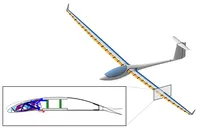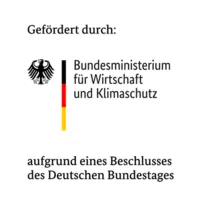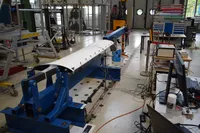In the LuFo project MILAN (Morphing Wings for Sailplanes), a full-scale demonstrator morphing wing segment has been designed, built, and tested in collaboration with project partners. It is a functional and structural demonstrator of the inner wing for a 18 m span high-performance sailplane with a morphing forward wing section (morphing leading edge). The test setup is shown in Figure 1.
A sailplane with a camber morphing forward wing section combined with a conventional trailing edge flap offers the potential to extend the laminar low-drag-bucket to higher lift coefficients. This allows the wing area to be reduced and the wing loading to be increased, while maintaining slow-flight performance. Higher lift-to-drag ratios, especially at higher speeds can be achieved.
A series of elastically deformable ribs with compliant mechanisms is used to impose the desired deformation on the morphing wing skin (Reinisch 2019, Reinisch et al. 2021). By this, it is possible to switch between specific airfoils for different flight conditions. For fast flight, the airfoils have little camber, for slow flight the forward section is morphed down for more camber in combination with a downward trailing edge flap deflection. Special morphing airfoils and a wing planform have been designed and optimized for that (Achleitner et al. 2019).
A composite wing skin has been designed to achieve the desired shapes without buckling (Sturm and Hornung 2021). The primary wing structure for the demonstrator wing segment has been designed to withstand the loads despite the reduced thickness and smaller cross-sections. Static aeroelastic tailoring has been investigated to reduce wing twist (Sturm et al. 2021).
The demonstrator wing segment covers the inner wing up to 2400 mm half span and is extended with a steel beam to allow a representative wing bending to be applied with a crane (see Figure 2). Previous numerical investigations show that the superimposed wing bending influences the elastic airfoil deformation and leads to larger actuation forces. By means of a torque tube with a mechanical linkage, pull is applied to the lower wing skin at three points.
In the test, different wing bending deformations (jig shape, level flight, circling flight) were applied and the morphing forward section was deformed in in fast and slow flight configurations. The geometry was measured using photogrammetry and 3D laser scanning to analyze the airfoil contours (see Figure 3). Locally, strains of the shape-variable shell were recorded using strain gages.
Following the static tests, a low-cycle fatigue test of the morphing forward section was done. Currently, test analysis is ongoing.
Status: November 2022




